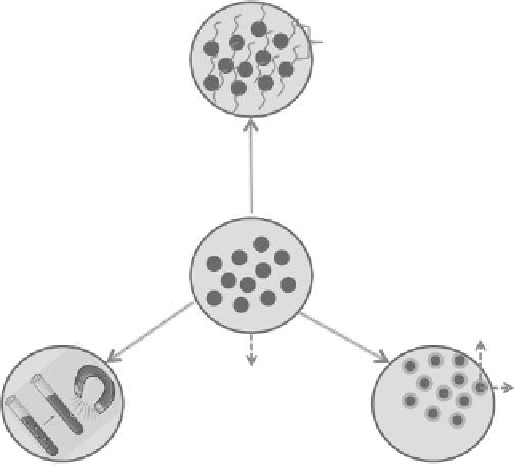Environmental Engineering Reference
In-Depth Information
Biotin
Functional
ligands
Iron oxide NPs-
large surface to
volume ratio
Core NP
FIGURE 19.4
Some desired properties of iron oxide magnetic NPs for water puriication. (From P. Xu, G.M. Zeng, D.L. Huang,
C.L. Feng, S. Hu, M.H. Zhao, C. Lai, Z. Wei, C. Huang, G.X. Xie, and Z.F. Liu,
Sci. Total Environ.
, 424, 1, 2012.)
hematite (9%), and ferrihydrite (14%) through a surfactant mediated-precipitation route
using cetyltrimethyl ammonium bromide. The Langmuir monolayer capacity value was
estimated to be 53.19 mg/g. They found an optimum equilibrium deluoridation capacity
at pH 5.75, and the capacity decreased with further increase in pH. Anion exchange (at
acidic pH) and van der Waals forces of attraction (at alkaline pH) are the dominant mecha-
nisms responsible luoride uptake.
Zirconium oxide is another transition metal-based oxide widely studied in water puri-
ication. Recently, Cui et al. [100] have synthesized zirconium oxide NPs though a hydro-
thermal route and studied its potential for arsenic removal. The material showed good
afinity to arsenic, both As(III) and As(V). In another effort, hydrous zirconium oxide was
synthesized through simple chemical precipitation and tested for its ability to scavenge
luoride from water [101]. The material showed high afinity to luoride, and maximum
adsorption capacities of 124 and 64 mg F
−
/g (of adsorbent) at pH 4 and 7, respectively, were
reported. On the basis of spectroscopic studies (Raman, Fourier transform infrared [FT-
IR], and
19
F nuclear magnetic resonance), the authors attributed the luoride removal from
water to the formation of Zr-F bonds on the hydrous zirconium oxide. They also proposed
a seven-coordinate polyhedral zirconium oxyluoride species (ZrO
2
F
5
) and possibly some
ZrO
3
F
4
formed on the adsorbent's surface by exchange reactions between surface hydroxyl
groups and luoride, based on x-ray photon spectroscopy data.
19.4.2 Embedded Metals and Metal Oxides/Hydroxides
Although metal oxides and hydroxides are eficient in scavenging luoride from aqueous
medium, most of these materials are available only as ine powders or are dispersed in
aqueous suspension. Although smaller-sized particles are desirable when fast kinetics is

